Disclaimer: This cartoon contains racist stereotypes and imagery that I do not in any way endorse. Presented purely for historical and informational context, I ask that you let me know if I say something that is harmful, offensive, or ignorant. I would like to take accountability in case that were to happen, as it is never my intent to do so. Thank you.
Release Date: November 5th, 1938
Series: Merrie Melodies
Director: Frank Tashlin
Story: Dave Monahan
Animation: A.C. Gamer
Musical Direction: Carl Stalling
Starring: Danny Webb (Thief), Mel Blanc (Lone Ranger, Police, Tuba Player), Sara Berner (Operator), The Sportsmen Quartet (Chorus), The Symphonettes (Chorus)
Described by Bob Clampett as "the world's largest Yo-Yo", Frank Tashlin was never known to stay in one place long. He was let go from the Schlesinger studio first in 1933 after telling Leon he could go to hell, denying him a percentage of his comic strip at the time. He went to Ub Iwerks' and later Hal Roach's studio before returning to Schlesinger's in 1936, where he was promoted as a director by Leon, who obviously shared no hard feelings.
Come 1938, Tashlin gets into an argument with associate producer Henry Binder, leading to his second firing. Tashlin would then head over to Disney's as a writer, working on cartoons such as Mr. Duck Steps Out, Mr. Mouse Takes a Trip, and even laying out some groundwork for Mickey and the Beanstalk and a very, very early draft of Lady and the Tramp. After his stint at Disney's was a trip to Columbia's Screen Gems studio, working as a storyman and eventual production manager in 1941.
Tashlin would return to Warner's for a third and final time in 1942. Norm McCabe, who had been drafted into the war, was slated to leave, but was still finishing up some work. Leon gave Tashlin to Bob Clampett's unit as a temporary position to wait out for McCabe's departure. As such, Clampett's A Corny Concerto credits Tashlin as the writer. Tashlin would then direct up until 1944 (the backlog of cartoons causing his last cartoon to be released in 1946), with Bob McKimson taking over his unit. Tashlin would then grow on to direct a number of live-action films and make a name for himself as a film director, one of his most notorious films being the Dean Martin and Jerry Lewis comedy Artists and Models (which, in many ways, feels like a live action Looney Tunes cartoon.)
To say Tashlin's career was lucrative is an understatement. As such, we find ourselves at the end of his first directorial stint with You're an Education. A fitting end to the "Tashlin Three", Tash concludes his "books come to life" trilogy with a focus on travel brochures from all around the world, with visual puns accompanied by fitting song numbers.
One of Frank Tashlin's many artistic interests was the world of stop motion. According to Bob Clampett, Tashlin's Swooner Crooner was intended to be a collaboration between the two directors, with a scene involving a hen factory being made in stop-motion. Sadly that never came to fruition, but Tashlin did do some stop motion work for John Sutherland after departing Warner's for the final time in 1944. The closest Tashlin did get to incorporating stop motion in his Warner works is in this very cartoon--a model of a globe spins in front of the camera before segueing to the animated cartoon at hand.
In our final Tashlin directed entry of his books come to life series, our story takes place not in a drugstore, not a library, but a travel agency. Even the rainfall doesn't hide the vibrancy of the Deco façade, with a lovely shadow of the window signage reflecting off the sidewalk.
The camera trucks into the window, a male chorus singing "Let the Rest of the World Go By" overtop. Instead of trucking straight into the shop, Tashlin instead cross dissolves to a shot of the camera looking inside the shop, the typography on the window separating the viewer from outside and in.
Zooming in on a brochure advertising a visit to Alsace Lorraine (which was reverted to French ownership at the end of WWI and thusly disestablished), the camera does a cross dissolve and zoom into the cover. Focusing on the lone castle in the brochure, the male chorus thus transitions to a score of "Have You Got Any Castles, Baby?", which was the title of Tashlin's previous "books come to life" installment.
Any visual reference or acknowledgment to Hawaii must be accompanied by a backing track of "Aloha Oe". Wonderfully vibrant colors and beautiful silhouette staging--the foreground of the palm trees and shrubbery really frames the cover nicely.
The first half of the cartoon is dominated by snatches of music accompanying whatever visuals lie on the brochures. Next, we dissolve to a brochure for Oxford, England, with college students competing in a rowing team (with monocles, of course.) Cue one "We're Working Our Way Through College" from Carl Stalling.
Sharp eyes will catch that the silhouettes dancing on the cover of a brochure for Vienna is reused from Friz Freleng's The Miller's Daughter, all the way back from 1934. As was the case with Daughter, the couple dance to a chorus of "The Blue Danube". Tashlin's colors and design sense are quite eye popping and visually engaging. Tashlin reused the same silhouettes for Speaking of the Weather in 1937 as well.
Interestingly enough, there lies more history in these scenes than mere reuses of animation. After the Vienna segment, there's a rather odd fade out to black and fade in to the next scene as opposed to a cross dissolve. That's a result of over 45 seconds of the cartoon getting cut for the Blue Ribbon re-issue in 1946. According to the cartoon's dialogue transcript (courtesy of Devon Baxter, who explores the issue in-depth), after the Vienna sequence was a number involving a caricature of Hugh Hubert and "Hooray for Hollywood". As Devon notes, it seems odd that Hubert's caricature would have been cut out for the 1946 release, considering he was still a relative Hollywood figure at the time.
Our next reuse comes from 1935's Flowers for Madame, with a line of flowers dancing to "The Campbell's Are Coming" in an advertisement for Scotland.
Avalon Bay (with real flying fish!) is scored to Al Jolson's "Avalon", in which the song mentions flying fish. The real Avalon Bay is located in California's Catalina Island.
Cue another rather shoddy exclusion from the re-issue; this time, a brief glimpse of a brochure for "sunny California" is shown in a dissolve before being replaced by the silhouette of an African native drumming to "Congo" (labeled as Flat Foot Flooji, a take on the popular 1938 song Flat Foot Floogie.) According to the dialogue transcript, the Sunny California sequence was to include a chorus of "All is Fair in Love and War."
Any caricature of a leprechaun representing Ireland must have him singing "Wearing of the Green." Or at least, Tashlin sets up the audience to think as such--the leprechaun quickly transitions to more modern music stylings, now singing a peppy rendition of "Bei Mir Bist du Schoen" as he dances behind the frame of his harp.
Silhouettes of dancing girls (reused from The Miller's Daughter and Billboard Frolics) adorn Mexico's travel brochure. Tapping into some of the gags he included in Little Pancho Vanilla, typography pops up on the brochure with one word after the other: "Land of chilis, tamales, and..." The "and" shivers for a few beats before revealing "and bicarbonate". As one can guess, the silhouettes dance to a lively score of "La Cucaracha".
A long pan of the Eiffel Tower is accompanied by a woman's chorus of "On the Rue de la Paix", with an oil rig at the very bottom. Lovely coloring on the tower, and the lettering on the ad (particularly "Paris") is wonderfully Tashlinesque and Deco.
Another cut is made before segueing to a brochure for England, the British Guards marching to "I Love a Parade", another title for a 1932 Merrie Melody. Once again, the technique for achieving depth through lighter cel paints in the second row is utilized. Shooting the scene as an overhead shot is indeed a very Tashlinesque maneuver.
A brochure for Capri is appropriately scored with "Isle of Capri", with a large wave crashing overtop the beachgoers, drawing them into the tide before splashing them back into place.
As is unfortunately the case with many of Tashlin's "book" cartoons, racist caricatures are inherent in 1930s cartoons about exploring the world. Here, "Night Over Shanghai" accompanies a grotesquely caricatured man pulling a rickshaw. As he did in The Major Lied 'til Dawn, Tashlin incorporates the motif of antiquated meets modern as the rickshaw has a 1930s trailer attached to the back. The staging and coloring of the scene, at the very least, is nice.
Dissolve to two Russian men hauling something off-screen to a dirge of "The Song of the Volga Boatman".
Or, at least, that is until they break out into the Cossack dance, animation traced over from Tashlin's own Cracked Ice.
After that is a brochure for Holland; with reused Ken Harris animation from Freleng's 1935 Little Dutch Plate, a girl and boy dance to a peppy score of "Puppchen", which was also a musical number in the aforementioned short.
Indeed, after the dance, the scene fades to black before dissolving to a pan. However, one can faintly make out the glimpse of another pan that was cut--according to the dialogue transcript, it seems as though a Greta Garbo caricature was to be included, with a chorus singing her catchphrase of "We vant to be alone."
In any case, the cartoon returns to its own uncut pan, an idea reused from the previous two book entries as all of the brochure stars (some caricatured much more politely than others) applaud the act. Amongst the crowd is one of the girls from Little Pancho Vanilla, as well as a facsimile of Johanna Spyri's Heidi from Have You Got Any Castles?
Things start to take a more Tashlinesque turn outside of his camera angles and composition. A rotund, geometric, Tashlin minded tuba player from Cuba churns out a chorus of "When Yuba Plays the Rumba on the Tuba", his face growing red thanks to a double exposure effect. His poses are very energetic and succinctly timed to the beat of the music.
A snake charmer from India (Speaking of the Weather and Have You Got Any Castles? had a similar caricature on the cover of "Asia" magazine) pipes his own chorus to the song. As is always the case, it's impressive how Carl Stalling can transform the same song into a completely different styling in the drop of a hat; the song turns from major to minor key to accompany the snake charmer.
Cue some geography gags as a baby promoting Little America shakes his rattle to the music, as well as a very offensively caricatured baby representing Asia Minor. Little America was a series of exploration bases in Antarctica, with the 5 stations spanning from 1929-1958. As of 1938, there would only be two bases established. Asia Minor, on the other hand, refers to the peninsula in western Asia, otherwise known as Anatolia.
From one crude caricature to the next, Tashlin reuses a gag from Have You Got Any Castles? with a caricature of Bill "Bojangles" Robinson ascending the step(pe)s of Russia. The stairs moving in perspective is at the very least a nice touch.
Bombay is self explanatory.
While Tashlin's quick cutting can sometimes get him into trouble, having a trigger finger and itching to cut too quickly, the deliberately quick cut between the bombs in Bombay to the mammy-esque chorus is incredibly practical and sharp in its musical timing. Stereotypes aside, the singers, rife with Tashlin's bulbous design sense, harmonize to the chorus of "When Yuba Plays the Rumba on the Tuba", and their vocals sound great.
Tashlin also flaunts his knack for perspective and tricky angles: the singers strut over to the right, the camera following them as they're eventually shot at an upward angle. The movement is strikingly smooth and flows wonderfully.
In a trick that he's been using since 1936 (Little Beau Porky comes to mind, only in the opposite to make Porky feel taller and frame for an upcoming gag), Tashlin accounts for the singers going off screen by panning the camera just a tad. He could have done a diagonal pan--pan right and up at the same time, but he instead waited to pan to the right, pause, and then up, which creates a much more (desirably) artificial and noticeable, theatrical effect.
The pan serves mainly as a reveal for the next gag, the women now singing a quick snatch of "The Lady in Red" as the woman in the middle hikes her dress up to reveal her red (long) underwear underneath. Scandalous!
With that, the woman's time to shine comes to a close after a quick percussive chorus from the Little America and Asia Minor babies, as well as another tuba solo and a rather random gag of a fish in an Indigenous headdress performing a war cry, racism explained by the brochure branding his advertisement for the Indian Ocean.
It seems another cut was made between the Indian Ocean gag and the shot of Billy Bletcher singing the same chorus as a Tibetan (another punny joke, seeing that it's actually a caricature of Opera singer Lawrence Tibett), the fade out and in (and brief halt in music) disrupting the flow. In any case, Bletcher's solo is a reminder of just how solid of a voice actor he was. With his roles either comedic or villainous, it's not often he was cast as a mere chorus singer. His deep voice is perfect.
Focusing on a literal, rocking translation of the rocky mountains, the woman chorus from before accompanies the animation once more, followed by more baby rattle rattling from Little America and Asia Minor.
Our tuba player from Cuba marks the end of the song as he strains to get the last notes out, no other musical accompaniment in sight. His design is a nice refresher, with fun, vibrant facial hues as he struggles for air and appealing expressions.
Dog panting sounds match the exhaustion that both he and his anthropomorphic tuba face.
And, as was the pattern in Have You Got Any Castles?, we're met with yet another rolling pan of the audience applauding the song number, this time panning right to left rather than left to right.
Pans with the audience applauding typically mark a shift in tone in Tashlin's entry, which is true in the next case as we segue into the song's eponymous song number, sung as "Food's an Education". Tashlin hones in on a brochure for Hungary, warped into a literal transition as the camera trucks out to reveal two famished Tashlinites. Hunger is a relatively difficult emotion to convey without prior context or dialogue, so props to Tashlin for still conveying that through one Hungarian massaging his aching stomach, the other drooling like a dog.
A waft of some good cookin' snakes onscreen, to which the Hungarians notice, their hat takes loose and full of energy. They follow the scent with audible sniffing.
The source is revealed to be a chef from the Cook Islands, a nation in the South Pacific. Here, the bulbous chef dishes two spoonfuls of Ambiguous Broth onto their plates. Once more, some fascinating perspective from Tashlin, who stages it at a slightly diagonal up-shot.
More intriguing perspective as they nab their utensils from a brochure for Twin Forks, Montana (a spoof on Three Forks, Montana), turkey from (where else?) Turkey, sandwiches from the Sandwich Islands, previously spoofed in The Isle of Pingo Pongo, and thousand island dressing from the Thousand Islands.
While each acquisition of a food item was merely cutting from one shot to the next, the next scene has the Hungarian twins nabbing their remaining food items in one long pan, a nice visual contrast from the previous sequence and an effective way to ease the flow. Hamburg hamburgers, Bermuda onions, and Chilean chili sauce.
"Oysters to spare", as indicated by the chorus off-screen, get their own close-up shot, the twins nabbing the oysters straight from Oyster Bay, New York.
For a sequence as potentially monotonous as it could be--especially on account of those puns--Tashlin does a great job of splitting up the visual interest with various shots and staging composition. We then cut to a close-up of the twins nabbing some china cups from China, filling it up with java from the Indonesian island of the same name.
And, for another change, rather than doing a straight cut to the next scene, there's instead a dissolve to the twins setting up camp near the Cape of Good Hope. Nice visual gag of the one Hungarian using the snowcaps on the mountains as a cloth for their picnic.
Back to our trio of singers, who finish out the song with a few belly slaps. While not uproariously funny or as engaging as Tashlin's previous works, Tashlin still manages to take a string of food puns and make them at least visually interesting, conscious of his transitions and staging. The vocals have no issue being catchy.
Another applauding montage--this time a double-exposed shot of a close-up and wide shot of the audience--to mark the last third of the cartoon. Again, as was the case in Speaking of the Weather and Have You Got Any Castles?, Tashlin saves the last part of the cartoon for an actual climax rather than a spot gag collection.
Enter a much more furtive and suspicious atmosphere as a man pops his head out from the Bagdad brochure. Ensuring he's not seen, he silences the audience with rhythmic "Shh! Shh! Shh! Shh! Shh!"s, his poses full of elastic energy.
He tinkers along the bookshelf in perspective, halting only to spare a few more looks and rhythmic shushes.
Putting his environments to handy use, he snags a ladder from a brochure for the Pueblos of Arizona. Using it to escape from the bookshelf on which he is trapped, he begins to step down...
...and ends up breaking the entire ladder in one swift, incredibly smooth piece of animation and camera pan down. Wonderful weight and rhythm, accented by Stalling's piano glissando and eventual crash.
"Shh!"s are furious as he recovers, as though the audience is responsible for the noise. I imagine that got quite a handful of laughs in a theater.
He adjusts his turban with a pop, which has smacked itself into one horizontal cloth instead.
Tashlin executes yet another fascinating camera pan--it's supposed to read as though the camera is panning upwards and past the man as he sneaks past the brochures. In fact, the camera pan is on a single, horizontal shot--it's the man and the bookshelf that is animated going out of sight. The result is very flowing and borderline hypnotic.
Borrowing his camera techniques from Little Pancho Vanilla, Tashlin executes another "pan-n-reveal" move: the camera pans over to a brochure advertising the diamond mines of Kimberly, South Africa. A sudden truck out of the camera reveals that the man has been standing there the entire time, a purposefully jarring effect as he rubs his hands together.
Who knew the Florida Keys could be so helpful?
Utilizing his keys, the thief easily unlocks the gate guarding the mines and sneaks through. Treg Brown's sound effects serve as the guesswork; the audience knows from the rattling alone that he's snagged a diamond.
Indeed, the thief emerges from the mines with a single diamond, heading off to his next line of attack as the camera pans past more brochures and onto a nearby baby toy. Speaking of the Weather also utilized babies in its climax--or, rather, impersonating them.
Tashlin has been a solid director since day 1, which makes it even more rewarding to see him borrow from himself, consciously or not. The walk cycle of the thief as he sneaks into frame, stepping on the baby toy, is incredibly similar in its posing to the walk cycle by Ali-Mode in Little Beau Porky, one of Tashlin's earliest effort. Despite his growth, the Tashlin style will stay the same--and that, in this case, is a very, very good thing.
In any case, the noise of the toy (a duck quacking) causes the baby on a nearby brochure to wake up screaming. With the thief making a mad dash for it, the camera trucks out to reveal the classic pun: the baby from Wales wails.
The phone operator's line of "Give me Radio City! Hurry, hurry, please!" sounds comparatively muffled, though that very well could be a result of the current print of the cartoon (or re-issue) and not the actual cartoon itself.
Instead of the fabled line of "Calling all cars, calling all cars", a disembodied voice calls all countries from a tower in New York. Seeing as Radio City Music Hall was constructed in 1932, it would have been a relatively new building at that point. "Kimberly diamond mine has been robbed."
3 years later, and the Tarzan call from Buddy of the Apes of all cartoons is still getting plenty of reuse. Instead, the cry is supposed to read as a siren (which probably would have been funnier) seeing as the brochure is branded as Tahiti -- See the South Sea Sirens. In any case, the said sirens bellow their warning call as a signature Tashlin montage is executed for one final time.
A man on the Cape Horn brochure does indeed trumpet a fanfare, a call to arms as we witness all of the armies taking off: the Royal Guard from England, the Foreign Legion from Morocco, Canada's Royal Mounted Police, as well as Indigenous and African tribes. Another pattern established from the previous two "book" cartoons.
Enter Education's innocuous superhero, a detective from Scotland Yard (a literal translation on the travel brochure.) With a plethora of smoke and tobacco billowing from his pipe, he enlists in the aid of his binoculars to scout out the trouble.
A scanning of the various maps before him through the lens of the binoculars. While seeing things through the binocular lens may read as a cliché now, it's certainly a much more engaging device than the alternative, having the detective look to the left, do a wild take, and cut to whatever it is he saw. Here, he stumbles upon the thief getting his diamond assessed by a man from the Pawnee tribe, a pawnbroker's sign hanging above his tipi in another meeting of modern and antiquated.
The shots of the detective jumping heroically from shelf to shelf read relatively synonymous in flow to similar setups in Porky's Double Trouble, another Tashlin cartoon. Here, the detective pursues the thief himself, prompting the thief to jump off-screen into a nearby automobile. While still a long way from totally smooth movements, the studio's camera department has been getting progressively comfortable and better at their camera pans, which really heighten the urgency of the chase here and allow things to flow like liquid.
Struggling to get his jalopy to start, the thief finally gets it to sputter into gear and out of frame, all timed succinctly to the music. The detective repeats the same shtick with the same sharp timing and sound effect percussion.
Props to the ink and paint department, the unsung heroes of these cartoons as the cartoons take off with a blur. Paint streaks comprise the scene more than the characters themselves. The action of the detective firing guns at the thief is almost made irrelevant just by the technique of the brush strokes alone--it calls back similarities to Tex Avery's own high speed, brushy car chase in Gold Diggers of '49.
As fate would have it, the Leaning Tower of Pisa plays a hand in the chase, leaning so far that it spills out of its brochure and crashes onto the bookshelf. Thus, the thief is launched out of his car in a nice flowing pan, flopping to a halt in front of some West Point guards.
The West Pointers live up to their name. A handful of pokes are given to the thief right in the eyes. Meanwhile, Mt Vesuvius spews loose shrapnels of boulders and rocks onto the thief as he makes a getaway off-screen. The lack of hook-up poses is a little jarring, reading as a jump cut as the thief practically hops into frame, but was likely used for the sake of time. The original cartoon was 45 seconds longer than the surviving copy, which would have totaled at nearly 8 minutes.
Tashlin gets technical with some nice double exposure effects on London's famous fog as the thief seeks the clouds for a hideout, disappearing altogether. A pause as we linger on Carl Stalling's triumphant music score of "Sing, You Son of a Gun".
Our detective is quick to foil the thief's refuge, enlisting in the aid of Holland's windmill to blow away the fog. Treg Brown's whistling sound effects boost the ferocity of the winds.
Elsewhere, in one of the more creative visual gags of the cartoon, a cowboy belonging to a dude ranch brochure lassos the thief up and drags him through the Red, Black, and Yellow Seas, each body of water dipping him in a new color. The cutting on the Yellow Sea scene is held slightly longer so as to emphasis its impact, indicating the new thief's hue du jour.
Italy boot gags were plenty in the world of golden age cartoons, and here is certainly no exception. Italy and a Missouri mule (guess what land of geography that brochure is advertising) engage in a game of "diamond thief in the middle" as they kick the villain back and forth. Tashlin's frequent cutting between the two are a nice way to disorient the viewer and establish a rhythmic yet purposefully jarring momentum.
One last kick is given by Italy, sending the thief flopping onto Silver, the Lone Ranger's horse--because why not? The thief taps his coach on the shoulder, prompting Silver to skid to a halt.
"Who are you?" Bletcher is instantly recognizable in his deep, rolling accent.
"I am the Lone Stranger!" Bob Clampett would appropriate that title for his upcoming cartoon, The Lone Stranger and Porky. Mel Blanc finally allows his voice to be heard 6 and a half minutes into the cartoon.
"Well, you're not alone now, big boy!"
"HIYOOOOOOOOOO, SIIIIIIILVEEEEEEER!"
Tashlin's first directorial stint comes to a close with a fitting iris out gag, one final goodbye as a yellow turban floats through the iris and into the darkness.
And thus puts a coda on Tashlin's second stint at Warner's. Education, unfortunately, isn't the brightest note to end on. A number of issues are out of Tashlin's control--arbitrary cuts and poorly masked transitions make the cartoon feel clunky, discombobulated, and incomplete.
Even without the arbitrary cuts, however, this is certainly far from Tashlin's best. A smattering of defamatory caricatures aside, the short is mainly a showcase of puns and songs. The songs are just fine and very catchy--even in the worst of cartoons (which this isn't at all), a good music score can at least make an effort to save the short. Meanwhile, the puns in this case are presented hardly with a sense of irony or sardonicism, which regresses the short and its humor (if any) back to the darker ages of Warner cartoons.
In any case, a "bad" Tashlin cartoon can be a "great" cartoon by other standards. Tashlin's still very strong in his camerawork; the pans have a nice rhythm and flow to them, the staging of the short (primarily the main title song sequence and the sequences with the thief) is innovative and visually engaging with intriguing perspective and camera angles, and Tashlin breaks up monotony however he can be mixing and matching different transitions to certain scenes. Not to mention, the cartoon is wonderfully colorful and vibrant, very energetic and thorough in its color and design choices. The more Tashlinesque designs (such as the tuba player) are a refreshing reminder that this is a 1938 Tashlin entry and not a 1935 Friz Freleng cartoon.
It becomes difficult to criticize the directors, especially this early on when the effects of the Depression were still being felt, on their animation reuse from previous cartoons. Theater audiences likely wouldn't know the difference, and saving money however you can is at the very least admirable. In any sense, the frequent recycling from '34 and '35 Merrie Melodies does inadvertently date the cartoon back to that era just a tad--largely in part due to the straight-laced approach of the cartoon as a whole. With very little irony in the delivery of the puns and a relatively straightforward villainous climax, this short follows the formula of Warner cartoons from '30-'35.
Being a book cartoon does little to alleviate that, as well as the racist caricatures. On another note, seeing as this is the third "books come to life" cartoon that Tashlin has made in a little over a year, fatigue from both the creator and the audience is bound to happen, and both seem to be felt here.
In any case, Education still has its high points. The vocal choruses are lovely, the camera movements and staging is great, and the colors are incredibly vibrant and stimulating. Seeing as Tashlin was let go, it's likely this cartoon may have been finished up by Chuck Jones, who inherited Tashlin's unit after he left. Such is usually the case in cartoons passing the torch (such as Bob Clampett and Art Davis' The Big Snooze, Tashlin and Bob McKimson's Hare Remover), lack of communication is bound to cause a lack of cohesiveness. Who's to say how far into production Tashlin was in this cartoon before he got fired--the fact that it still largely carries many of his earmarks is a feat in itself.
Which brings us to Tashlin's career as a whole. Tashlin is a very exceptional director in more ways than one. Having directed at Warner's twice, comparisons are bound to occur when discussing his '30s work and his '40s work. Take Friz Freleng for example, who also had a stint in the '30s and a stint in the '40s. Friz made some great '30s cartoons; his Buddy cartoons were typically the most solid, and his Merrie Melodies in an era dominated by droll Buddy cartoons were a godsend. He birthed the studio's first true star in I Haven't Got a Hat, and made some very funny cartoons before his departure for M-G-M. However, when discussing his work, his '40s work and onward is immediately what comes to mind and what gets the most praise.
While Tashlin can be in that same boat, there isn't as large of a disparity between the quality of his work in both decades, because he was just that solid of a director. His '30s cartoons focused more on composition and camerawork, whereas his '40s cartoons prioritized design and angular, dynamic movement. From day 1, Tashlin started off strong--Porky's Poultry Plant still holds up as a wonderfully snappy and cinematographic, exhilarating cartoon, especially the climax. Porky's Romance is one of my personal favorites--Tashlin was the only director who got away with showing Porky commit suicide (and fail) on screen. Wholly Smoke is a powerhouse of a cartoon with strong parallels, an innovative story, and sharp filmmaking skills. The Case of the Stuttering Pig, while unfortunately aged poorly by antisemitic caricatures, remains a very strong and atmospheric cartoon that is an incredibly compelling argument of what makes Tashlin as a director so unique. He wasn't trying to imitate others so much as he was trying to pave new ways himself--something that would continue on through his '40s career.
It is genuinely difficult to say goodbye, even though he'd return 5 years later with Porky Pig's Feat, indisputably a masterpiece and very likely the best black and white cartoon put out by the studio. Frank Tashlin is truly a different specimen, and his absence--the lack of speed, the lack of sharp timing, whether it be behavioral, comedic, or animation, the lack of cinematography--is felt in many, many ways. In any case, his absence allowed Chuck Jones to grace the director's seat, who would stay seated all the way up until 1962, when he was fired for moonlighting on UPA's Gay Purr-ee.
But, better cartoons await, and Tashlin's reunion is sure to be welcomed with open arms.
And so, a little parting wisdom... he who laughs last, laughs last!















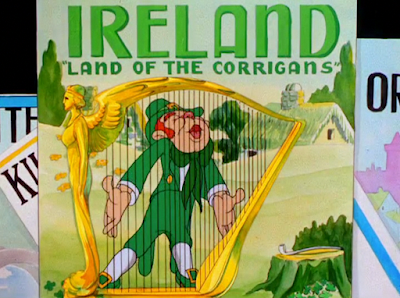

























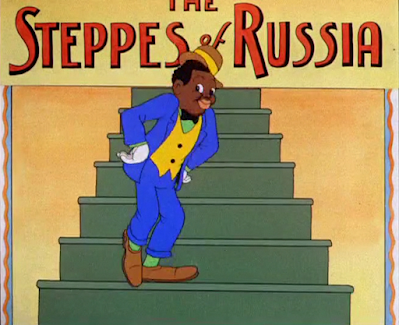












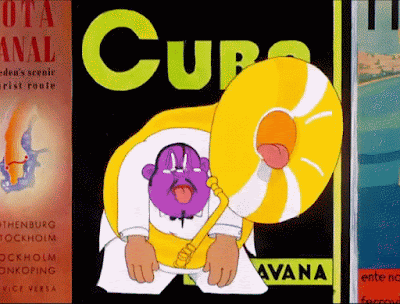






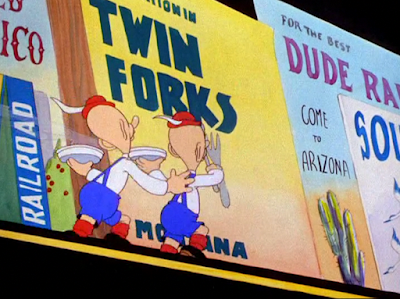



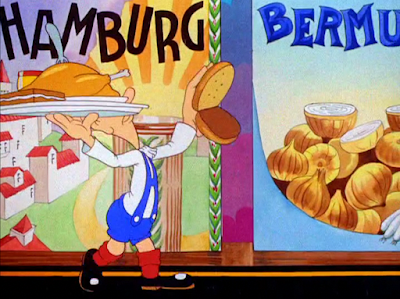

























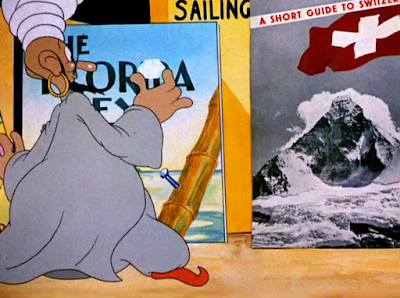

















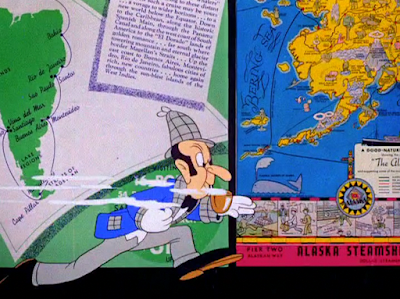





























No comments:
Post a Comment